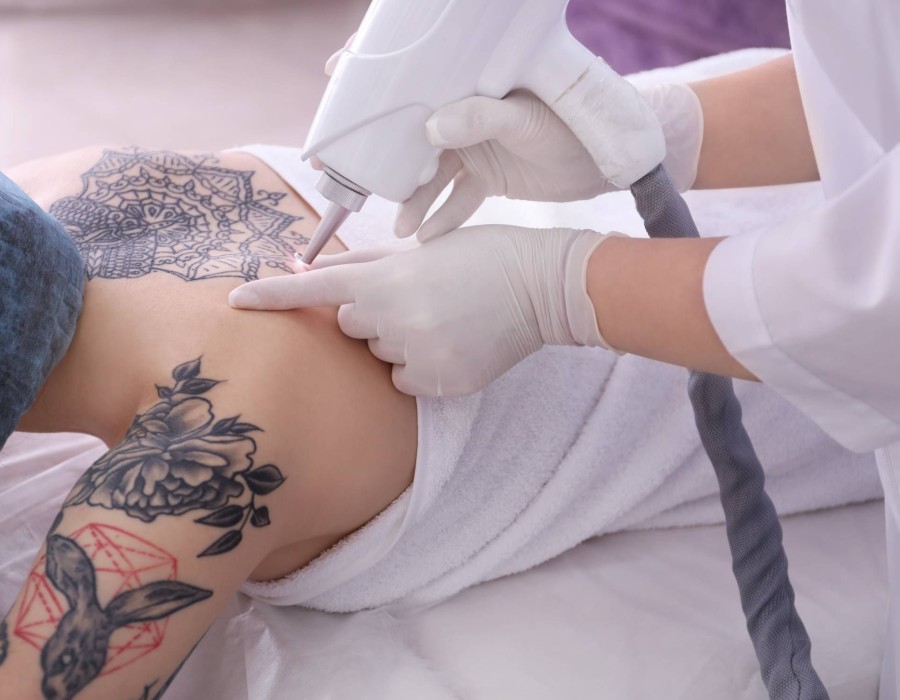Removing a tattoo is often a deeply personal decision. Whether it’s to erase a past memory, make room for new ink, or simply for aesthetic reasons, laser tattoo removal has become the go-to solution. While the procedure itself is effective, proper post-treatment care is crucial to ensure optimal healing and minimal side effects. Self-care after laser tattoo removal plays a significant role in the recovery process, helping to soothe the skin and promote healthy regeneration.
When undergoing Laser Tattoo Removal in Dubai, many individuals overlook the importance of aftercare. The process involves breaking down ink particles in the skin, which can leave the treated area sensitive, swollen, and vulnerable to infection if not properly cared for. Proper healing requires a focused self-care routine that minimizes discomfort and prevents complications. Understanding the right steps to take post-treatment will enhance your recovery and ensure your skin heals beautifully.
What to Expect After Laser Tattoo Removal
The first step to effective self-care after laser tattoo removal is knowing what to expect. Immediately following the procedure, you may experience redness, swelling, and a mild stinging sensation in the treated area. This is perfectly normal and similar to the feeling of a mild sunburn. The skin might also appear white or frosty, a common reaction called "frosting," which occurs due to the heat generated by the laser.
Over the next few days, the skin may blister, scab, or peel. It’s essential to resist the urge to pick or scratch the area, as this can lead to scarring or infection. The healing process varies depending on factors like your skin type, the size of the tattoo, and how many treatments you've had. But with proper care, most people see significant improvement within two weeks.
Immediate Care After the Procedure
Keep the Area Clean and Dry
One of the most important self-care steps is keeping the treated area clean. Gently wash the area with mild soap and water 24 hours after your procedure. Be careful not to scrub the skin; instead, pat it dry with a clean towel. Avoid using harsh or fragranced soaps, as these can irritate the sensitive skin.
Apply an Ointment
After cleaning, applying a healing ointment is essential to protect the skin and prevent infection. Antibacterial ointments like Aquaphor or Neosporin can create a barrier that keeps bacteria out while allowing the skin to heal. Be sure to apply a thin layer to avoid clogging the pores.
Cover the Area with a Bandage
Covering the treated area with a sterile bandage can further protect it from dirt, germs, and other environmental factors that may cause infection. Change the bandage daily or as directed by your dermatologist or technician, ensuring the area remains dry and clean.
Managing Discomfort
Cold Compresses for Swelling
It’s common to experience some swelling after laser tattoo removal, especially in the first 24 to 48 hours. Applying a cold compress can help reduce inflammation and alleviate any discomfort. Use a clean cloth and wrap it around an ice pack or a bag of frozen peas, and gently press it against the treated area. Avoid placing ice directly on the skin, as this can cause frostbite.
Over-the-Counter Pain Relief
If you’re experiencing pain or tenderness, over-the-counter pain relief medications like ibuprofen or acetaminophen can help. These medications reduce inflammation and provide temporary relief from any discomfort. However, avoid aspirin as it can thin the blood and increase the risk of bruising.
Protecting the Skin During the Healing Process
Avoid Sun Exposure
One of the most critical self-care tips after laser tattoo removal is protecting the skin from sun exposure. The treated area is more susceptible to sun damage, which can slow the healing process and cause pigmentation issues. For at least two weeks post-treatment, avoid direct sunlight and tanning beds. If you need to go outside, cover the area with clothing or use a high-SPF sunscreen (30 or above).
Skip the Gym
Exercise is generally beneficial for health, but after a laser tattoo removal session, it's best to avoid strenuous activities for at least 48 hours. Exercise can increase blood flow to the treated area, which might exacerbate swelling or cause blistering. Sweating can also irritate the sensitive skin and increase the risk of infection.
Wear Loose Clothing
Tight clothing can rub against the treated area, causing irritation or friction burns. Opt for loose-fitting clothing made from breathable materials like cotton. This will reduce the risk of aggravating the skin and allow it to heal undisturbed.
Avoiding Complications
Don’t Pick or Scratch
As tempting as it may be, avoid picking at scabs or scratching the treated area. Picking at scabs can cause permanent scarring and delay the healing process. If the itching becomes unbearable, applying a fragrance-free lotion or taking an antihistamine can help alleviate the irritation.
Watch for Signs of Infection
While infection is rare after laser tattoo removal, it’s still essential to be aware of the signs. If you notice increased redness, warmth, pus, or a fever, it’s crucial to seek medical attention immediately. Early detection can prevent more severe complications.
Follow Up with Your Dermatologist
Regular follow-up appointments with your dermatologist or technician are essential to monitor the healing process and plan future treatments. Your provider can offer additional advice based on how well your skin is healing and recommend the best course of action for subsequent sessions.
Long-Term Care for Best Results
Stay Hydrated
Keeping your skin hydrated from the inside out is a crucial part of the healing process. Drink plenty of water to promote overall skin health and help your body flush out the ink particles broken down by the laser. Hydration aids in skin elasticity and regeneration, which will help the treated area heal more efficiently.
Moisturize Regularly
In addition to keeping your skin clean and protected, moisturizing is essential for maintaining its health after laser tattoo removal. Opt for a fragrance-free, gentle moisturizer that won’t irritate the treated area. Applying moisturizer after the skin has started to heal (usually after a few days) can prevent dryness and help the skin regenerate.
Be Patient with the Process
It’s important to remember that tattoo removal is a gradual process. Depending on the size, color, and depth of your tattoo, you may need several sessions to achieve your desired results. Be patient with your skin as it heals and regenerates. Avoid rushing into the next treatment session before your skin is fully healed from the previous one, as this can lead to unnecessary complications.
Additional Tips for Optimal Healing
Avoid Smoking and Alcohol
Both smoking and alcohol can impair your body’s natural healing process. Smoking reduces oxygen flow to your skin, which can slow down the recovery process, while alcohol can dehydrate your body and impede skin regeneration. To promote optimal healing, consider reducing or eliminating these habits during the recovery period.
Use Gentle Skincare Products
After laser tattoo removal, your skin will be sensitive, and it’s essential to avoid using any harsh skincare products that could irritate the treated area. Steer clear of products containing retinoids, alpha hydroxy acids (AHAs), or beta hydroxy acids (BHAs) for at least two weeks after your procedure. Stick to gentle, non-comedogenic products that focus on hydration and soothing the skin.
Conclusion
Self-care after laser tattoo removal is essential to ensure a smooth and effective healing process. By following the tips mentioned above, you can minimize discomfort, prevent infection, and promote healthy skin regeneration. Keep the treated area clean, moisturized, and protected from the sun, and be patient with the process. Tattoo removal is not instantaneous, but with the right care, you’ll be on your way to achieving clear, ink-free skin. Always consult with your dermatologist or technician for personalized advice based on your skin type and the specific details of your tattoo removal journey.






Comments